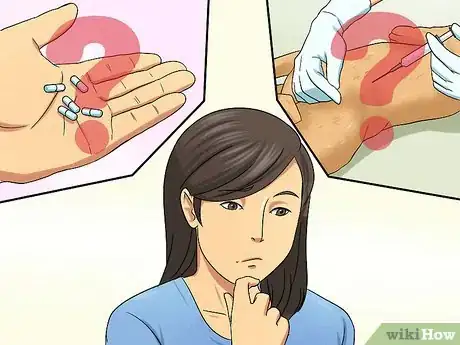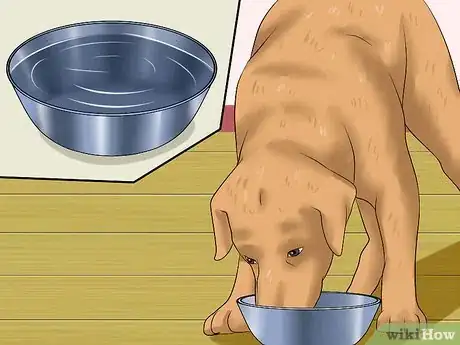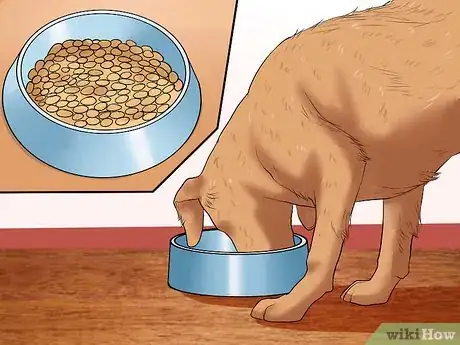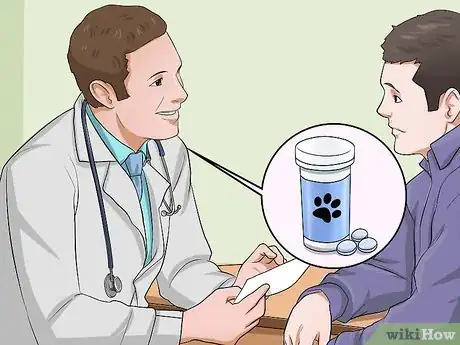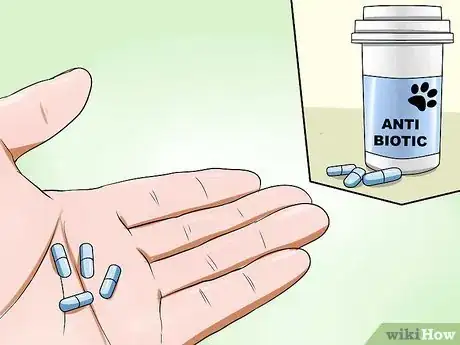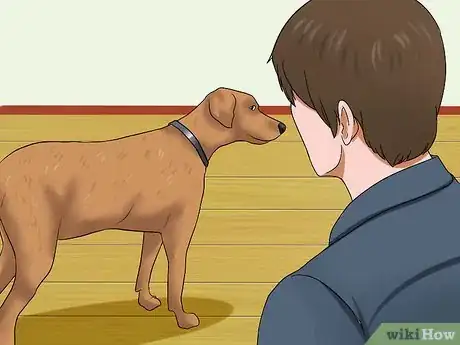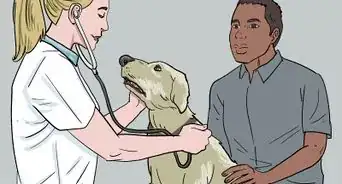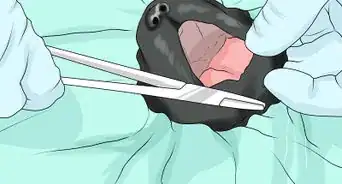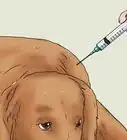This article was co-authored by Pippa Elliott, MRCVS. Dr. Elliott, BVMS, MRCVS is a veterinarian with over 30 years of experience in veterinary surgery and companion animal practice. She graduated from the University of Glasgow in 1987 with a degree in veterinary medicine and surgery. She has worked at the same animal clinic in her hometown for over 20 years.
This article has been viewed 52,459 times.
The dog flu (medically termed canine influenza) is an infection that can be passed from dog to dog. If your dog has come down with this flu, it is best to see a veterinarian for formal diagnosis and treatment. Treatment normally consists of a combination of rest, hydration, and sometimes medications (both for symptom management, as well as antibiotics to prevent secondary bacterial infection). If your dog is otherwise healthy, they should recover after about a week. If your dog has a preexisting health condition, such as heart or kidney disease, then they will need plenty of nursing care to support them through a difficult time.
Steps
Using Supportive Care
-
1Understand that there is no medical "cure" for canine influenza. Rather, your dog's veterinarian will offer what is called "supportive care." Supportive care is basically a combination of symptom management and rest, so that your dog's immune system is optimized and best able to fight off the virus. Your dog's immune system is the only thing that can actually fight off the bug itself.
- Keep your dog's eyes and nose clean. Wipe these areas down with a cotton pad soaked in water that has been boiled, then cooled to room temperature.
- Make sure your dog's bed has plenty of padding. If your dog isn't moving very much, they can develop bed sores. Provide additional padding with a few extra blankets.
- Keep your dog indoors and make sure it is not too hot or too cold.
-
2Give your dog fluids. The vet may offer your dog extra fluids, sometimes via an IV, if your dog has become dehydrated as a result of fighting off canine influenza. If the dehydration is only mild, encouraging your dog to drink more water orally may be sufficient.
- A dog needs to drink 50 milliliters (1.7 fl oz) of water for every kg body weight (so, if your dog weighs 22kg or 50 lbs, they need 1,100 ml of water daily). If your dog is not motivated to drink, you can syringe water in through the side of their mouth in small, frequent doses throughout the day.
Advertisement -
3Encourage your dog to eat. A sick dog may not have much interest in eating, but it is important for your dog to keep their strength up. If your dog will not eat, try warming some wet or canned food and offering it to them. The dog may allow you to hand-feed them or may be interested in eating their favorite treats. If nothing seems to be working, ask your vet about Oralade, a liquid food that you can give your dog via syringe.
-
4Ask about medications for symptom management. While it is never wise to try and give your dog human medications (such as Tylenol, Advil, or other cold and flu medications), your vet can advise you as to pet-friendly alternatives that can help to decrease the bothersome symptoms for your dog, as his or her immune system works to fight off the virus. Speak to your vet if you would like medications to help with pain, fever, and/or runny nose and congestion symptoms in your dog (all of which are often present in cases of canine influenza).
Preventing Complications
-
1Opt for antibiotics for your dog. Although canine influenza is a viral infection, many veterinarians will offer your dog antibiotics in order to prevent what is called a "secondary bacterial infection." What this means is that, while your dog's immune system is busy fighting off the virus, it can become weakened and susceptible to bacterial infections. The antibiotics help to prevent this, and to ensure that your dog has the quickest recovery possible.
-
2Prevent the spread of infection to other dogs.[1] While your dog is recovering from canine influenza, it is important to keep them at home and isolated from other dogs. The virus can be spread through droplets, so if your dog sneezes around other dogs, the infection can spread. Avoid public places with other dogs such as doggy daycare, doggy boarding places, and public dog parks. Although it can be a hassle to keep your dog at home, you would appreciate the same done by another dog owner if his or her pet was infected.
- Make sure you wash your hands after touching your dog or anything that might be infected (your dog's food bowl, toys, bedding, etc.) and before you touch another dog.
- If you work during the day and need care for your dog, consider hiring a dog walker for the duration of the illness.
- They can stop in during the day to check in on your dog, and walk your dog while avoiding the need to go to a public place where other dogs could become infected.
-
3Monitor your dog's progress. Your dog should begin to feel better over the course of a few days to a week or so, and symptoms should begin to dissipate and ultimately disappear. If you find that your dog is getting worse, or failing to show any signs of improvement after one week, bring them back to the vet for a follow-up examination. It could be that your dog needs additional care, and/or hospitalization in the more severe cases. Although this is rarely needed, it is best to see your vet and to be safe rather than sorry.
- Watch for signs of dehydration, especially if your dog does not seem to be drinking much water.
- Check to make sure your dog is not soiling themselves, especially if they are not moving from their bed.
- Check your dog's temperature twice daily. A normal temperature is between 100 and 102.5°F (37.7 and 39.4°C).[2]
- If your dog has an underlying health conditions, such as heart or kidney disease, then you will need to take extra measures to support them as they fight the infection. Work with the vet to ensure they are getting the necessary care, which may include staying at the veterinary clinic.
Expert Q&A
-
QuestionHow can you tell if a dog has the flu?
 Pippa Elliott, MRCVSDr. Elliott, BVMS, MRCVS is a veterinarian with over 30 years of experience in veterinary surgery and companion animal practice. She graduated from the University of Glasgow in 1987 with a degree in veterinary medicine and surgery. She has worked at the same animal clinic in her hometown for over 20 years.
Pippa Elliott, MRCVSDr. Elliott, BVMS, MRCVS is a veterinarian with over 30 years of experience in veterinary surgery and companion animal practice. She graduated from the University of Glasgow in 1987 with a degree in veterinary medicine and surgery. She has worked at the same animal clinic in her hometown for over 20 years.
Veterinarian The signs are those of a nasty upper respiratory tract infection and include fever, coughing, sneezing, runny eyes, and nose. Your vet can make a definitive diagnosis (should it be necessary) by swabbing the throat or by a blood sample.
The signs are those of a nasty upper respiratory tract infection and include fever, coughing, sneezing, runny eyes, and nose. Your vet can make a definitive diagnosis (should it be necessary) by swabbing the throat or by a blood sample. -
QuestionCan you give your dog the flu?
 Pippa Elliott, MRCVSDr. Elliott, BVMS, MRCVS is a veterinarian with over 30 years of experience in veterinary surgery and companion animal practice. She graduated from the University of Glasgow in 1987 with a degree in veterinary medicine and surgery. She has worked at the same animal clinic in her hometown for over 20 years.
Pippa Elliott, MRCVSDr. Elliott, BVMS, MRCVS is a veterinarian with over 30 years of experience in veterinary surgery and companion animal practice. She graduated from the University of Glasgow in 1987 with a degree in veterinary medicine and surgery. She has worked at the same animal clinic in her hometown for over 20 years.
Veterinarian No. The strain of flu virus that causes infection in dogs is a mutated horse virus. It is extremely infectious between dogs, but there is no evidence that dogs can give it to people or cats, or indeed that the human flu virus can be passed to dogs.
No. The strain of flu virus that causes infection in dogs is a mutated horse virus. It is extremely infectious between dogs, but there is no evidence that dogs can give it to people or cats, or indeed that the human flu virus can be passed to dogs. -
QuestionIs there a vaccine for the dog flu?
 Pippa Elliott, MRCVSDr. Elliott, BVMS, MRCVS is a veterinarian with over 30 years of experience in veterinary surgery and companion animal practice. She graduated from the University of Glasgow in 1987 with a degree in veterinary medicine and surgery. She has worked at the same animal clinic in her hometown for over 20 years.
Pippa Elliott, MRCVSDr. Elliott, BVMS, MRCVS is a veterinarian with over 30 years of experience in veterinary surgery and companion animal practice. She graduated from the University of Glasgow in 1987 with a degree in veterinary medicine and surgery. She has worked at the same animal clinic in her hometown for over 20 years.
Veterinarian Yes. There is an effective vaccine against both forms of dog flu. This is given by subcutaneous injection. It protects against flu and is best given to healthy dogs ahead of exposure to the flu virus. In some cases, it doesn't completely stop infection but it will make the symptoms less severe in that individual.
Yes. There is an effective vaccine against both forms of dog flu. This is given by subcutaneous injection. It protects against flu and is best given to healthy dogs ahead of exposure to the flu virus. In some cases, it doesn't completely stop infection but it will make the symptoms less severe in that individual.
References
About This Article
To treat dog flu, add extra layers of padding to your dog’s bedding so it doesn’t develop bed sores. Additionally, wipe your dog’s eyes and nose with a cool, damp cotton pad to keep them clean and comfortable. You should also offer your dog plenty of water so it doesn’t become dehydrated. Alternatively, consider using a syringe to squirt water into it’s mouth in small, frequent doses. If its symptoms don’t improve within a week or get worse, bring your dog to the vet. For tips from our Veterinary co-author on how to keep dog flu from spreading to your other pets, read on!
